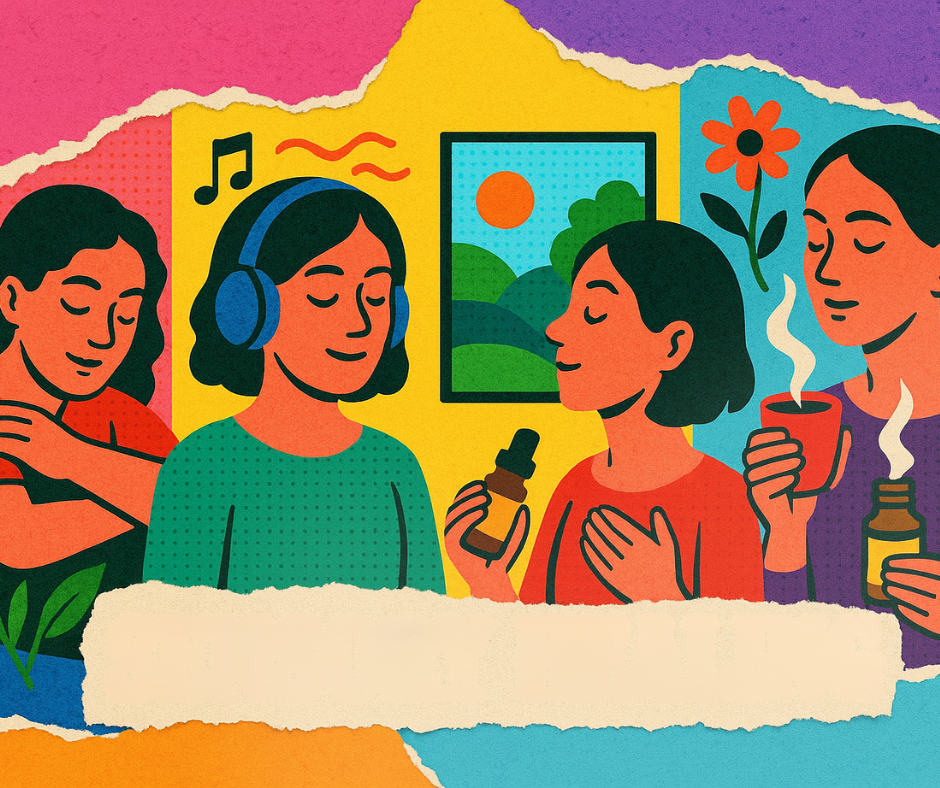/ Nov 05, 2025
Trending

Rob Streisfeld, NMD
In a fast-paced, digitally saturated world, stress, anxiety, and mental health challenges are increasingly common. While traditional therapy and medication remain essential for many, a growing body of evidence points to the remarkable power of natural, sensory-based therapies—specifically color, light, aromatherapy, and sound frequencies—to support mental and emotional well-being. These holistic practices, grounded in ancient traditions and backed by modern science, are now integrated with modern technology. Emerging research in integrative medicine and neuroscience highlights the powerful impact of programmed environmental stimuli on reducing stress and promoting overall wellness.
Color therapy, or chromotherapy, involves using specific colors to elicit psychological and physiological effects. Simple changes—like repainting a room or using colored light bulbs—can positively impact mood and stress levels.
Color has long been known to evoke emotional responses. Each color influences the brain and body in specific ways:1,2
– Blue is calming and associated with peace and trust.
– Green soothes and restores balance.
– Yellow stimulates optimism and energy.
– Red increases alertness and energy.
– Purple is often linked to spirituality and mindfulness.
Color psychology suggests that specific hues can evoke emotional and physiological responses. Cool tones like blue and green have been shown to reduce heart rate and anxiety, creating a calming atmosphere conducive to relaxation and mental clarity.3 In therapeutic settings, carefully curated color palettes are increasingly used to support stress reduction and enhance mood regulation.
Light therapy, also known as phototherapy, has become a mainstream approach to treating Seasonal Affective Disorder (SAD), a form of depression linked to the lack of natural sunlight during winter months. Exposure to bright light—especially early in the morning—can reset the body’s circadian rhythm, regulate melatonin production, and boost serotonin levels, all of which are critical to mood and sleep.4,5
Full-spectrum light exposure has also been found to improve focus, reduce fatigue, and increase feelings of vitality. Red and near-infrared light (low-level laser therapy), known as photobiomodulation, is being explored for its neuroprotective effects, potentially reducing symptoms of anxiety and cognitive decline. Furthermore, red and near-infrared light therapy has been linked to improved sleep quality, reduced inflammation, and enhanced mood through its effects on cellular energy and neural signaling.6
Aromatherapy uses essential oils from plants for therapeutic purposes and works through the olfactory system to affect the limbic system—the brain’s emotional center.7 Research supports the effectiveness of certain essential oils:8,9
– Lavender: Calming and reduces cortisol.
– Bergamot: Lowers heart rate and improves mood.
– Frankincense: Promotes relaxation.
– Peppermint and eucalyptus: Relieve mental fatigue.
– Ylang ylang: Supports emotional release.
These can be used in diffusers, topical applications, or inhalation during meditation or relaxation routines.
It has been said that music can heal the soul. Culture and community have used sound and song for many purposes throughout time. Sound therapy is based on using resonant frequencies to rebalance the body’s natural rhythm:10,11
– Binaural beats influence brain states.
– Solfeggio frequencies restore balance.
– Singing bowls and gongs promote deep relaxation.
– Nature sounds recalibrate the nervous system.
These modalities have been shown to reduce anxiety, improve sleep, and enhance mindfulness. Binaural beats and natural sounds can slow brainwave activity, enhance parasympathetic tone, and promote a meditative, restorative state.
While powerful, combining color, light, aromatherapy, and sound amplifies their impact. A digitally programmed, multisensory experience, perhaps thought to be stimulating, can quiet the mind and restore peace. Multisensory environments that integrate these elements have synergistic effects in reducing stress and promoting overall wellness.12
These practices are simple, affordable, and effective ways to support mental health daily. As modern technology integrates with healthcare, wearable devices, virtual reality glasses, telemedicine, and AI will play an increasing role in treatment options and opportunities.
Online platforms and in-office “experiential” systems are being introduced to offer accessible and effective approaches to creating a balanced mind and body. Initial studies show a powerful positive impact on anxiety, depression, addiction, and more. Could modalities as basic as color, light, sound, and smell offer the best solutions for mental health support and overall well-being? The potential for this “energetic psychedelic” treatment option is surely one to keep an eye out for.

Dr. Rob Streisfeld is a passionate consumer advocate and educator with
over 20 years of Natural Health & Natural Products Industry experience. A
Doctor of Naturopathic Medicine and Certified Natural Food Chef, “Doc
Rob” as widely known, provides an informed and innovative perspective to
support education, product development, branding, marketing, PR, and
other business development needs.
Over the past decade, Doc Rob has helped to identify and expand key
health categories such as probiotics, enzymes, whey protein, fermented
foods, whole food supplements, and more. His focus on traditional and
cultural aspects of food and therapies offer unique insight on a wide
variety of topics.
Rob Streisfeld, NMD
In a fast-paced, digitally saturated world, stress, anxiety, and mental health challenges are increasingly common. While traditional therapy and medication remain essential for many, a growing body of evidence points to the remarkable power of natural, sensory-based therapies—specifically color, light, aromatherapy, and sound frequencies—to support mental and emotional well-being. These holistic practices, grounded in ancient traditions and backed by modern science, are now integrated with modern technology. Emerging research in integrative medicine and neuroscience highlights the powerful impact of programmed environmental stimuli on reducing stress and promoting overall wellness.
Color therapy, or chromotherapy, involves using specific colors to elicit psychological and physiological effects. Simple changes—like repainting a room or using colored light bulbs—can positively impact mood and stress levels.
Color has long been known to evoke emotional responses. Each color influences the brain and body in specific ways:1,2
– Blue is calming and associated with peace and trust.
– Green soothes and restores balance.
– Yellow stimulates optimism and energy.
– Red increases alertness and energy.
– Purple is often linked to spirituality and mindfulness.
Color psychology suggests that specific hues can evoke emotional and physiological responses. Cool tones like blue and green have been shown to reduce heart rate and anxiety, creating a calming atmosphere conducive to relaxation and mental clarity.3 In therapeutic settings, carefully curated color palettes are increasingly used to support stress reduction and enhance mood regulation.
Light therapy, also known as phototherapy, has become a mainstream approach to treating Seasonal Affective Disorder (SAD), a form of depression linked to the lack of natural sunlight during winter months. Exposure to bright light—especially early in the morning—can reset the body’s circadian rhythm, regulate melatonin production, and boost serotonin levels, all of which are critical to mood and sleep.4,5
Full-spectrum light exposure has also been found to improve focus, reduce fatigue, and increase feelings of vitality. Red and near-infrared light (low-level laser therapy), known as photobiomodulation, is being explored for its neuroprotective effects, potentially reducing symptoms of anxiety and cognitive decline. Furthermore, red and near-infrared light therapy has been linked to improved sleep quality, reduced inflammation, and enhanced mood through its effects on cellular energy and neural signaling.6
Aromatherapy uses essential oils from plants for therapeutic purposes and works through the olfactory system to affect the limbic system—the brain’s emotional center.7 Research supports the effectiveness of certain essential oils:8,9
– Lavender: Calming and reduces cortisol.
– Bergamot: Lowers heart rate and improves mood.
– Frankincense: Promotes relaxation.
– Peppermint and eucalyptus: Relieve mental fatigue.
– Ylang ylang: Supports emotional release.
These can be used in diffusers, topical applications, or inhalation during meditation or relaxation routines.
It has been said that music can heal the soul. Culture and community have used sound and song for many purposes throughout time. Sound therapy is based on using resonant frequencies to rebalance the body’s natural rhythm:10,11
– Binaural beats influence brain states.
– Solfeggio frequencies restore balance.
– Singing bowls and gongs promote deep relaxation.
– Nature sounds recalibrate the nervous system.
These modalities have been shown to reduce anxiety, improve sleep, and enhance mindfulness. Binaural beats and natural sounds can slow brainwave activity, enhance parasympathetic tone, and promote a meditative, restorative state.
While powerful, combining color, light, aromatherapy, and sound amplifies their impact. A digitally programmed, multisensory experience, perhaps thought to be stimulating, can quiet the mind and restore peace. Multisensory environments that integrate these elements have synergistic effects in reducing stress and promoting overall wellness.12
These practices are simple, affordable, and effective ways to support mental health daily. As modern technology integrates with healthcare, wearable devices, virtual reality glasses, telemedicine, and AI will play an increasing role in treatment options and opportunities.
Online platforms and in-office “experiential” systems are being introduced to offer accessible and effective approaches to creating a balanced mind and body. Initial studies show a powerful positive impact on anxiety, depression, addiction, and more. Could modalities as basic as color, light, sound, and smell offer the best solutions for mental health support and overall well-being? The potential for this “energetic psychedelic” treatment option is surely one to keep an eye out for.

Dr. Rob Streisfeld is a passionate consumer advocate and educator with
over 20 years of Natural Health & Natural Products Industry experience. A
Doctor of Naturopathic Medicine and Certified Natural Food Chef, “Doc
Rob” as widely known, provides an informed and innovative perspective to
support education, product development, branding, marketing, PR, and
other business development needs.
Over the past decade, Doc Rob has helped to identify and expand key
health categories such as probiotics, enzymes, whey protein, fermented
foods, whole food supplements, and more. His focus on traditional and
cultural aspects of food and therapies offer unique insight on a wide
variety of topics.
It is a long established fact that a reader will be distracted by the readable content of a page when looking at its layout. The point of using Lorem Ipsum is that it has a more-or-less normal distribution of letters, as opposed to using ‘Content here, content here’, making it look like readable English. Many desktop publishing packages and web page editors now use Lorem Ipsum as their default model text, and a search for ‘lorem ipsum’ will uncover many web sites still in their infancy.
It is a long established fact that a reader will be distracted by the readable content of a page when looking at its layout. The point of using Lorem Ipsum is that it has a more-or-less normal distribution of letters, as opposed to using ‘Content here, content here’, making it look like readable English. Many desktop publishing packages and web page editors now use Lorem Ipsum as their default model text, and a search for ‘lorem ipsum’ will uncover many web sites still in their infancy.
The point of using Lorem Ipsum is that it has a more-or-less normal distribution of letters, as opposed to using ‘Content here, content here’, making

The point of using Lorem Ipsum is that it has a more-or-less normal distribution of letters, as opposed to using ‘Content here, content here’, making it look like readable English. Many desktop publishing packages and web page editors now use Lorem Ipsum as their default model text, and a search for ‘lorem ipsum’ will uncover many web sites still in their infancy.
It is a long established fact that a reader will be distracted by the readable content of a page when looking at its layout. The point of using Lorem Ipsum is that it has a more-or-less normal distribution
Copyright BlazeThemes. 2023